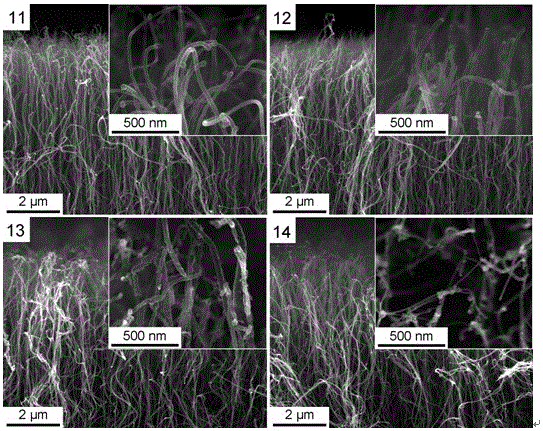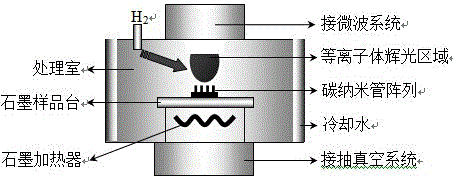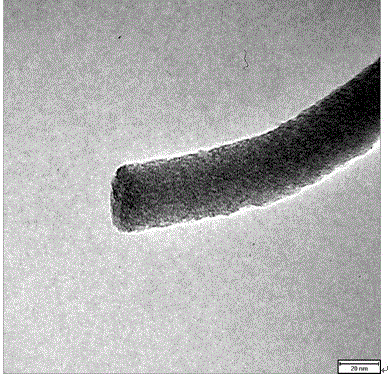A method for improving the field emission performance of carbon nanotubes by microwave hydrogen plasma treatment
A plasma and carbon nanotube technology, which is applied in the field of preparation and application of nanomaterials, can solve the problems of shortening the service life of carbon nanotube-based field emission cathodes, poor field emission stability, and reducing the field electron emission capability of cathode materials. The effect of improving field emission performance
- Summary
- Abstract
- Description
- Claims
- Application Information
AI Technical Summary
Problems solved by technology
Method used
Image
Examples
Embodiment 1
[0040] (1) Preparation of clean silicon wafer substrate:
[0041] First, cut the silicon wafer into small pieces of 2cm×2cm, clean them with ultrasonic (50W) in deionized water, acetone and absolute ethanol for 10 minutes, and then put the silicon wafer into hydrofluoric acid with a volume ratio of 4% for 5 minutes. Minutes for clean, contamination-free substrates free of silica overlays.
[0042] (2) Deposition of iron catalyst by magnetron sputtering:
[0043] The deposition of the iron catalyst was carried out in a magnetron sputtering device (commercially available). Prior to this, the silicon single wafer was pretreated by bombardment with energetic iron ions in a metal vapor vacuum arc ion source (MEVVA source, commercially available). The iron ion energy was about 15keV, the beam current was 10 mA, and the processing time For 15 minutes, this treatment can effectively improve the bonding force between carbon nanotubes and silicon substrates; then place the silicon waf...
Embodiment 2
[0053] (1) Preparation of clean silicon wafer substrate:
[0054] First, cut the silicon wafer into small pieces of 2cm×2cm, clean them with ultrasonic (50W) in deionized water, acetone and absolute ethanol for 10 minutes, and then put the silicon wafer into hydrofluoric acid with a volume ratio of 4% for 5 minutes. Minutes for clean, contamination-free substrates free of silica overlays.
[0055] (2) Deposition of iron catalyst by magnetron sputtering:
[0056] The deposition of the iron catalyst was carried out in a magnetron sputtering device (commercially available). Prior to this, the silicon single wafer was pretreated by bombardment with energetic iron ions in a metal vapor vacuum arc ion source (MEVVA source, commercially available). The iron ion energy was about 15keV, the beam current was 10 mA, and the processing time For 15 minutes, this treatment can effectively improve the bonding force between carbon nanotubes and silicon substrates; then place the silicon waf...
Embodiment 3
[0066] (1) Preparation of clean silicon wafer substrate:
[0067] First, cut the silicon wafer into small pieces of 2cm×2cm, clean them with ultrasonic (50W) in deionized water, acetone and absolute ethanol for 10 minutes, and then put the silicon wafer into hydrofluoric acid with a volume ratio of 4% for 5 minutes. Minutes for clean, contamination-free substrates free of silica overlays.
[0068] (2) Deposition of iron catalyst by magnetron sputtering:
[0069] The deposition of the iron catalyst was carried out in a magnetron sputtering device (commercially available). Prior to this, the silicon single wafer was pretreated by bombardment with energetic iron ions in a metal vapor vacuum arc ion source (MEVVA source, commercially available). The iron ion energy was about 15keV, the beam current was 10 mA, and the processing time For 15 minutes, this treatment can effectively improve the bonding force between carbon nanotubes and silicon substrates; then place the silicon waf...
PUM
| Property | Measurement | Unit |
|---|---|---|
| diameter | aaaaa | aaaaa |
| diameter | aaaaa | aaaaa |
| thickness | aaaaa | aaaaa |
Abstract
Description
Claims
Application Information
 Login to View More
Login to View More - R&D
- Intellectual Property
- Life Sciences
- Materials
- Tech Scout
- Unparalleled Data Quality
- Higher Quality Content
- 60% Fewer Hallucinations
Browse by: Latest US Patents, China's latest patents, Technical Efficacy Thesaurus, Application Domain, Technology Topic, Popular Technical Reports.
© 2025 PatSnap. All rights reserved.Legal|Privacy policy|Modern Slavery Act Transparency Statement|Sitemap|About US| Contact US: help@patsnap.com



